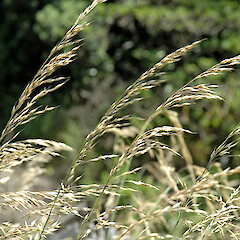Arrhenatherum elatius subsp. elatius
Common name
tall oat grass
Family
Poaceae
Flora category
Vascular – Exotic
Structural class
Grasses
Conservation status
Not applicable
Habitat
Terrestrial.
Detailed description
Tallish, erect, tufted, perennial grass. Roots fibrous, yellow to orange. Stems rounded, emerging leaves rolled; sheaths smooth with yellow to orange base. Leaves long and narrow, 100–400 × 4–10 mm, flat, harsh, dull bluish-green, with yellowish lines when held to light, usually with scattered hairs above, bitter taste. Ligule 1–3 mm long, membranous, white, serrate along edge. Seedhead a narrow panicle. Seeds large, oat-like, with papery covering and a spiky appearance (awned) (Weed Manager).
Year naturalised
1871
Origin
Eurasia, Nth Africa
Reason For Introduction
Agricultural
Life Cycle Comments
Perennial.









